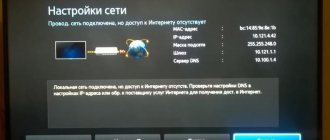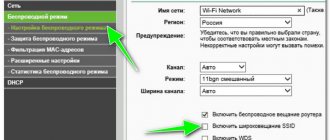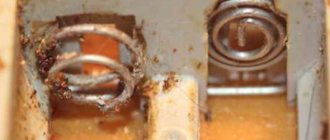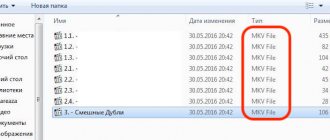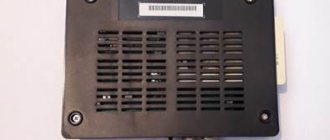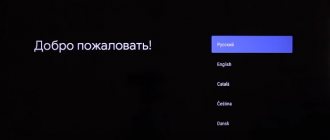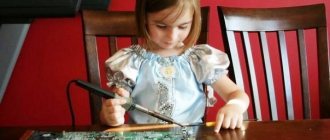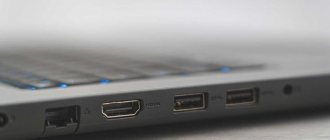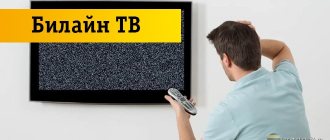Flash drives and external hard drives connected to a modern TV, Sony, Samsung or Philips are very convenient. From such drives you can watch movies, display photos, and listen to music. But it happens that the TV does not see the flash drive. What to do in this case depends on the nature of the problem. There are several possible incompatibility options. Most of them, if the flash drive has not failed, can be eliminated on your own.
Why can't the video play on my computer?
Often, people use a computer as a home multimedia system.
But there are situations when the desired film that you have been looking for for a long time and wanted to watch is not played. And you see the picture when the player displays a message about the impossibility of reading the video file. Or we cannot watch the film, however, our computer produces sound. Why sometimes videos on my computer won't play? In this article, we will describe in detail instructions on what to do in such situations. If you follow the recommendations, you will be able to enjoy watching your favorite movie. One of the main problems with movie playback is the content of different video storage formats. Because today there are a huge number of them, both the well-known AVI, MOV, ASF, MKV, OGG, and other less common ones.
Let's figure out what a “codec” is.
"Codec" is translated from English as a program that encodes or decodes various signals. This article will be about encoding exclusively video signals. Encoding helps compress the original huge stream into suitable data sizes so that everyone can stream and store video in a reasonable file size.
Video files are encoded with different codecs, depending on which they have different formats. For example: in the well-known format, MKV uses codecs such as H.261, H.263 or others. However, to view it, we must provide the system with the programs it needs to decode the image.
Virus check
Then why is the flash card seen by the computer, but not read? One reason could be a virus that infects the boot file of the USB drive. Because of this, the device either does not boot at all or is immediately blocked by the antivirus. And if it is displayed, it displays a warning “Access denied” when you try to open it.
First of all, you should destroy the infected boot file “autorun.inf”. To do this, enter the address of the flash drive in Explorer (for example, G:/):
Further:
- "Service";
- "Folder properties";
- "View";
- “Hidden files and folders”;
- "Show hidden files and folders."
The download file will now be displayed. It must be removed and data from the entire device scanned with an antivirus.
If the flash drive does not open through Explorer, use the command line:
- start;
- execute;
- command “cd F:/” (or your own drive letter);
- command “attrib -a -s -h -r autorun.inf”;
- "Enter";
- command "del autorun.inf";
- "Enter".
It is not recommended to disable the antivirus, as a virus from a USB drive can infect your computer.
What about the standard Windows video player?
If, when you open the Windows Media program on your computer, a window appears that says that the file type is not supported, what should you do to prevent it from displaying an error?
You need to install a codec on your system; for the selected video file, you need a specific codec suitable for Windows. If you don’t want to go deeper into the problem, download packages of the most popular codecs. One of which is the K-Lite Mega Codec Pack, to find it, use the Google search engine. It is worth noting that the package is free and it will provide your device with the codecs you need.
After downloading, it is important to start installing it. Don’t worry that the installation will be in English, click the “Next” or “Further” button, after installation is complete the package will be installed on your PC. You can also avoid installing unnecessary codecs by checking them in dialog boxes during the installation process. However, if you don't know which ones specifically you need, it's best to leave the K-Lite Mega Codec Pack installed as default.
The next step is to restart your PC and check if the video file already works with the required codecs. But there are problems worse than installing codecs. Because Windows Media has a large number of limitations in supported formats. The solution to this situation is to change the player to one that is suitable for the format of the downloaded video.
Problems and their solutions
One of the most popular and, unfortunately, insoluble options is that the USB input is simply not provided for servicing a flash card . It's hard to believe, but it happens. This input on a TV is made strictly to update the device’s software.
Inappropriate model
If the TV does not play video from a flash drive, most likely the input for the flash card is really not intended for this purpose. The TV model does not provide such functions. The newer the device, the less likely it is that this reason explains the inability to watch the video. But there is still a way out.
- You can reflash the device. True, not every TV is suitable for such an upgrade; of course, the user himself is unlikely to cope with it. But a master can get down to business and turn a seemingly hopeless case into a solvable situation. It’s better not to get involved in flashing the firmware yourself; the consequences may be irreversible.
- Go to the engineering menu . But this is not very simple, because such a step can only be taken with the help of a special service point. On the forums you can read a “hacker” tip: log in using two infrared diodes. But this is a very dangerous step. The engineering menu should be entrusted to professionals. If the user himself accidentally selects the wrong function, he may accidentally reset all settings.
Therefore, only those who have solid experience in this and clearly understand what they are doing should interfere with the operation of equipment. For the rest, it is better to contact an experienced master.
Does not support this video format
Another option to explain the problem is when the TV simply does not see the video and, as a result, does not show a movie or other video. In such a situation, you can try to correct the situation like this.
- The video file should be processed on a computer with a special program, i.e., it should be converted. That is, the video itself needs to be translated into a format that the TV supports.
- You can use an HDMI cable connecting to your computer. This way you can ensure that the TV acts as a monitor. It is important to correctly configure the video card by checking the settings on the device.
Finally, it’s worth starting with the instructions - read what formats the TV supports and download videos only in these formats. Or pre-convert the video to the desired file so that there are no difficulties with viewing.
Old software
There is no option other than updating the software . If the TV has an Internet connection function, then you can do this yourself, quickly and without problems. But there is another option: download the official instructions from the manufacturer’s website and install the software manually , checking the instructions in the instructions.
If problems arise here, you need to call the service center, and specialist operators will explain how to resolve the issue. Very often, the TV does not play video on the flash drive precisely because of unupdated software, so you just need to make it a good habit to regularly check for updates. It happens that the user simply sends service offers for software updates and does not know that the TV is ready to work in a more comfortable mode.
Other reasons
There are modern LCD TVs that fundamentally retain the parameters for limiting video playback sizes. For example, LG, Samsung, Sony, and Philips work with a limited number of video sizes. And it is impossible to bypass such limits. Therefore, owners of such TV models most often purchase an HDMI cable and connect the computer to the TV directly.
What else could be causing the video to not play?
- The file name may be incorrect. Some TVs do not “understand” the Cyrillic alphabet, and therefore files should be named with numbers or Latin.
- File system errors occur. For example, if the TV previously read a flash drive without problems, but suddenly stopped recognizing it, this indicates errors on the drive itself. You should connect the flash drive to the computer, call up the context menu, right-click and follow the following chain: “Properties – Tools – Check disk – Run check.” Next, you will need to check the “Automatically correct system errors” line.
- The USB port is faulty. Maybe it's worth starting by checking the port's operation. If he does not see any flash drive or cable, he may need to contact a service center to fix the problem.
It happens that the TV does not recognize the audio tracks of video files (does not support certain codecs). In this case, you also need to convert the video or download the same movie in a different format.
Try other video players
If you have space on your PC, it's a good idea to download another player. Launching your movie will be simple: go to downloads and find the desired file, right-click on it and the “open with” dialog box will appear where you select the downloaded player program. With the new program there is no need to install codecs, the player will successfully play your movie.
There are codec packages that, when installed, create a video player. For example, the famous K-Lite Mega Codec Pack comes with Media Player Classic. Pros of the video player: this application is free and plays a large number of video files, and in case of an incomplete or damaged file, it can easily play it.
Another common player program is VLC Media Player. It supports most formats, both well-known and lesser known. The program is free and has a GNU license. Supports playback of formats: FLV, TS, streaming video and many others.
KMPlayer - can play different formats, and even those that do not depend on the original PC codecs. Because the program contains built-in decoders. Thanks to KMPlayer, there is no need to install a codec package, and this saves the system, which, if there are many codecs, can lead to problems in the Windows media subsystem.
All the previously mentioned video players are updated regularly, which helps you open more and more diverse video files.
Problems combining codecs on one PC
It is worth noting that an excessive number of downloaded codecs will sooner or later lead to problems with video and audio playback. Because different codecs may not be compatible with other versions and therefore they do not replace each other and may be of the same formats, but from different developers. What to do in such situations?
First, remove all codec packs from your PC. Go to “Start”, then “Control Panel”, open “Uninstall programs”. There you will see downloaded codec packages, try to remove everything. To do this, select the programs and press “Delete” on the keyboard.
Professional repair
If your TV does not display some video formats, and you cannot cope with this problem yourself, immediately call the service center. The quality of work of our specialists is high; we carry out all work quickly and efficiently:
- We will perform initial diagnostics of your device and identify problems.
- If necessary, we will install licensed software and all necessary drivers.
- We'll adjust your TV settings and check your device's support for certain video formats.
- We will provide consultation on file conversion issues, as well as on established restrictions on video size (if any).
Also, the reason why video playback does not work can be a human factor - files incorrectly recorded on the media (the video is played, but there is no sound when viewing), physical damage to the flash card, etc. If this is the case, our specialist will diagnose these problems.
In order to extend the life of the device, you must also carefully monitor its condition:
- Avoid high humidity in the room.
- Promptly clean from dust and other contaminants.
- Make sure that the software is not exposed to viruses - do not use suspicious media for this. If the TV has Internet access, make sure to install an antivirus program for your model.
It often happens that during the diagnostic process hidden defects are revealed that can lead to serious damage. Our technicians will repair your device and, if necessary, perform routine maintenance.
Lack of video card drivers
If the three methods did not help and the video does not play on your computer, then it is likely that the video card driver is not working correctly or is missing altogether. You are unlikely to notice problems on your desktop until you encounter a video file playing.
Open Device Manager in Start, then in the Video Adapters section, find the name of your video card. If there is no question mark next to the name, which indicates a problem in the system, then everything is fine with the driver.
Otherwise, go to the hardware manufacturer's website and download the latest drivers for your video card, or simply find the driver disk that came with your video card.
Install the drivers. After restarting the computer, the problem with playing video files should stop. We hope that in this article you found the answer to the question “Why the video does not play on the computer.”
Memory card capacity
Many TV models have clear restrictions on the maximum memory capacity of connected devices. It cannot be ruled out that this limitation was the reason that the TV does not read the flash drive. Many TVs do not read devices whose memory exceeds the 32 gigabyte mark.
Open the instructions for your TV and read the information regarding maximum volume restrictions. These restrictions cannot be changed. The only solution is flashing. However, only specialists can handle such work. Modern TVs from Philips, Sony, Samsung, LG and devices from other manufacturers allow you to watch movies on flash drives and 64 GB. Restrictions are mainly found on older TV models.
Video does not play on the computer: what to do?
This doesn’t happen often, but sometimes it happens: some video files on a computer or laptop simply won’t run. Let's try to deal with this problem.
Many users have their computer installed as a multimedia center for watching TV series and movies. But a fresh operating system without modifications is poorly suited for playing video files. There are several reasons why you won't be able to enjoy the latest season of Game of Thrones or another new series. So, what to do if the video on your computer does not start?
Required OS updates for operation
When Windows XP is installed, the flash drive may not be recognized due to outdated updates required for its operation. However, some flash drives can work in PC USB ports, while others cannot.
The main updates required for normal operation of USB devices:
- KB925196 – incorrect recognition;
- KB817900 – port operation stops after the device is removed and reloaded;
- KB968132 – errors when connecting several flash drives;
- KB88740 – Rundll32.exe error;
- KB895962 – stops the USB device after turning off the printer;
- KB871233 – the flash card does not work after the PC wakes from sleep or hibernation;
- KB314634 – support only older USB devices;
- KB312370 (2007) – USB 2.0 support.
Installing codecs
Although Windows developers are modernizing their products every year and adding new features to them, the multimedia space is developing much faster. Every year new video formats and encoding types appear that improve their predecessors. The Windows Media Player built into the operating system, like other standard tools, is inferior to third-party software and cannot play all video formats.
Codecs are programs for compressing and playing media data. Each codec corresponds to a specific format. Windows Player also has its own set of programs for working with video files, but it is very modest. Therefore, the first thing to do in case of problems with video playback is to install the latest codec package. The most popular set is the K-Lite Codec Pack. The installation process is no different from installing regular programs.
We use alternative players
If a set of codecs did not help you and the video does not play, you can try updating the player. Better yet, download an analogue from a third-party developer. As mentioned above, standard tools do not have the widest capabilities. Many popular media players are initially equipped with a huge database of codecs, and also work better with audio tracks.
Here is a set of players that you can try, each with its own characteristics.
- KMPlayer is a universal solution that can handle any format.
- GOM Player - has a function that automatically finds the latest versions of codecs and updates them on the device.
- VLC Player - plays videos in MTS format from camcorders and cameras without any problems.
Update video card drivers
Another important condition for correct playback of video files is the normal operation of video card drivers. Here the situation is similar to standard codecs. With each version of Windows, the driver base expands, but there are graphics adapters that remain unnoticed by developers. In addition, new versions of software for video cards appear quite often.
It is very easy to check the performance of the video adapter.
Go to computer properties and select Device Manager . In the window that appears, open “ Video adapters” and if you see a yellow exclamation mark, it means the device is not working correctly.
On the official website of the developers you can download both the current driver separately and a program for setting up the video card. Nvidia has Geforce Expirience . For AMD it is Radeon Software. It is preferable to choose programs because you can regularly monitor driver updates.
TV is not designed for viewing files on a flash drive
This may seem surprising to many, but even if a USB connection port is present, this does not mean that you can watch movies and videos recorded on a flash card or external drive. A natural question arises: “Why then do you need an entrance?” The answer is simple - it is intended solely to update the device software.
At the same time, by seeking help from an experienced technician who professionally repairs TVs, you can find a way out of the situation:
- Reflash your device. It is important to remember that not every model lends itself to this kind of upgrade. Moreover, this must be done with great care - after all, one wrong step can lead to complete damage to your TV.
- Go to the engineering menu. There are also certain difficulties here - this can only be done with a special service remote control. Some users suggest performing this maneuver using two infrared diodes, but this route is very dangerous. It is recommended to entrust access to the engineering menu only to professionals, since if you select the wrong function in it, you risk messing up all the TV settings, as a result of which its functional and performance characteristics may suffer.
Interfering with the operation of equipment is a dangerous undertaking, especially if your knowledge is limited only to how to turn it on and select the desired channel. Therefore, when deciding to take this serious step, entrust all the work to experienced TV experts.
Installing codecs
If everything is in order with the drivers, proceed to check the other component required for video playback - codecs. Their absence leads to the fact that the video does not open or plays jerkily. Another typical situation is that the player displays a black screen, but there is sound.
Codecs should be distinguished from video formats. Let's say the built-in Windows Media Player can play files in AVI format. But video encoded by DivX, XviD or x264 can be packed into this format. As a result, it turns out that the format is the same, but some files do not open. To eliminate this drawback, you need to install a codec package.
The K-Lite Codec Pack is suitable for Windows. To be sure to fix playback problems, download the K-Lite Codec Pack Standard version.
It is important to install the codecs correctly, checking all the necessary components.
- Launch the installer, select the “Advanced” mode.
- Select profile 1 “Standard playback” to add the maximum number of codecs. The first item, by the way, is the Media Player />
Once the installation is complete, try playing a video that you couldn't open before. It will launch in the player you selected when installing codecs.
Adviсe
You should definitely check how much the film weighs. If there is a video on a flash drive that weighs 20, 30 or even 40 GB, not all TVs will be able to support this video size. Older models are rarely equipped with such capabilities. Files between 4 and 10 GB are most convenient in this regard.
If the TV does not have a USB port at all, you can take an old DVD player or digital set-top box. They usually have the required entrance. To connect, just switch to the set-top box or DVD. And then, taking the remote control for this device, select the USB connection. That is, the launch will be virtually the same as on the TV.
The video below discusses the reasons for video not playing from a USB flash drive and how to eliminate them.
Using third party players
Instead of installing codec packages, you can simply ditch Windows Media Player and start using more powerful and functional media players. To play different video formats, we recommend the following programs:
- KMPlayer is a universal player for playing files of any format.
- GOM Player - offers the Codec Finder function, which is responsible for automatically searching for missing codecs on the Internet.
- VLC Player - supports almost all known codecs, easily plays videos in MTS format from camcorders and cameras.
All of the listed players have a built-in codec pack and can play video from the Internet and broken files. For comparison, Windows Media Player does not have a single similar function, but, for example, Media Player />
By the way, if the video does not play in a third-party player that has its own codec pack, then it makes sense to remove the K-Lite Codec Pack. This will eliminate the conflict between codecs installed on the system and added with a third-party media player.
Problems playing online videos
To play videos on the Internet, you do not need codecs on your computer. Previously, Adobe Flash Player was responsible for display, but now browsers are gradually abandoning Flash, replacing it with the more secure HTML5 technology. Therefore, if you try to update Flash Player in your browser, you will see this message:
However, among the components of the same Chrome there is a flash player. Moreover, the product support forum even advises updating it by going to chrome://components/.
Another possible reason is that Java Script is disabled in the browser. To make sure it works (using Chrome as an example):
- Open Settings, click Show Advanced Settings.
- In the Personal Information section, click Content Settings.
- Make sure sites are allowed to use Java Script.
In other browsers, the procedure is performed in a similar way. You can prohibit the use of Java Script for all sites, and then configure exceptions by adding specific addresses - for example, Odnoklassniki, VKontakte, YouTube, Instagram.
The USB port on the TV is blocked
Let’s assume that the removable storage device is working properly, then a completely logical question arises: why doesn’t the TV see the flash drive? The problem may lie in a faulty connector. The catalyst for port failure is mechanical damage and short circuits. If the flash drive comes away from the connector, it is probably broken.
Another reason for problems with a port is blocking. Near the blocked connectors there is a corresponding inscription “USB service only”. This means that the interface is intended solely for repair work. It is possible to unblock such ports, but only specialists can do this. Contact the service center to have the technician reflash the interface. Most TVs are equipped with several USB connectors. Therefore, if next to one there is an inscription “USB service only”, just insert the flash drive into another port.
Videos cannot be played on the computer or on the Internet
Welcome to the pages of our blog moicom.ru. Why the video does not play on your computer, today you will learn how to solve this problem and what measures need to be taken to solve this problem.
In the last publication I talked about useful F8, read the article, watch the video lessons and don’t forget to click on the social buttons at the end.
If there is no video, then there may be two problems:
- The files you need from your computer (hard drive, regular drive, flash drive, or any other media) cannot be launched.
- Video cannot be played on the Internet, that is, in any browser (Opera, Mozila Firefox, Google Chrome, Internet Explorer, Safari, etc.)
You downloaded a new movie, brought it on a flash drive, or any other video file, but when you play it, an error appears: “The corresponding codec (decoder) was not found on the computer.” There is sound, but no picture, or there is neither one nor the other and there is just a black screen.
The flash drive is detected, but it is not visible in Explorer
This means that the sound of connecting a flash drive was heard, a removable media icon appeared in the system tray (near the clock), but the Flash drive is not detected in “My Computer”. In the simplest case, the drive letter for the flash drive was not assigned. Press “Win + R” and write:
diskmgmt.msc
Find the flash drive in the Disk Management window; the easiest way to determine it is by size. Mine is 8GB, it’s a little less than the real ones - 7.46 GB. My drive is called “SMBB”, you can see that there is no drive letter next to the name. All other drives have letters, so they are visible in “My Computer,” but the flash drive is not. At the same time, the file system is determined, here it is “FAT32”.
To assign a drive letter:
- Right-click and select “Change drive letter or drive path”;
- Click the “Add” button;
- Select any drive letter, for example “ E ”;
- Check that your flash drive should now appear normally in Explorer.
If the file system is not FAT32 or NTFS, then your version of Windows cannot work with it. To save the data, you need to copy it on the computer where the flash drive works normally, then you can format the disk on a new computer. If this is not possible, then for any case there is a solution on the Internet.
It’s bad if the file system is not detected in any way, the label “Unknown” or “Not initialized” is displayed, or one partition is in the “Not allocated” state. This means that the media will have to be formatted. This happens when there are system failures during data recording, unsafe removal of the flash drive from the laptop, incorrect or incomplete formatting, virus attacks, or faulty flash memory. To safely remove removable media, click on the device icon in the system tray and select “Eject Mass Storage Device (device name)”:
If the information that should be on the drive is important, then formatting will not work; first you need to try to restore the documents. For a new flash drive, Windows itself will prompt you to format it, then you will see the message “You need to format the disk in the drive... before you use it.”
FORMATTING DESTROYS ALL DATA!
To format a disk in the “Disk Management” window, right-click on the flash drive and select “Format”:
- We write any name (volume label);
- I recommend setting the file system to NTFS , it is a more reliable system than FAT32 ;
- Cluster size, Quick format, Compression of files and folders – leave them at default.
If you see the alert “This is the active partition of this disk... the data will be deleted...”, this means that your flash drive was bootable, just agree. After formatting, check whether the drive letter is assigned.
What is a codec
A codec is a special program needed for decoding audio and video files. To improve our lives (view more vibrant, high-quality videos and music files), programmers have come up with a large variety of different video formats. For each of them, you respectively need to download a specific codec.
Video does not play on computer
How to solve this problem so that your computer plays certain (desired) audio and video files? You need to download and install an additional program with codecs.
I recommend installing complete kits, they are regularly replenished and updated - K-Lite Mega Codec Pack. After installing them on your computer, you will probably forget this problem with playing audio and video files.
This link will help you download the program from my blog. The official website of the codec developer program is in English. If you understand English, you can use the official website (of the original source). There are always the latest versions of products.
I’ll warn you right away that you won’t be able to quickly download from there—you’ll need to follow several links before you find the one you need. This version, which is located on my blog, I think will be quite relevant.
Download, extract and install. During the process, you will be asked to install the universal Media Player Classic player, I recommend using it. It is simple, reliable and easy to use and plays almost all files without any problems.
Once everything is downloaded and installed, there is no need to launch codecs separately. We find any audio or video file we need, run it, everything should work fine.
If you run a file that didn’t work before, then you did everything correctly. If the problem remains unresolved, then I recommend that you read the instructions on how to download and install codecs, which I will publish in the following articles.
Video does not play on computer | Moicom.ru
Internet video does not work
Video files on the Internet on You Tube, Ru Tube and other resources are played using a small Adobe Flash Player.
If you have problems viewing them on Internet pages, I recommend installing or updating Flash Player to the latest (latest) version. Thanks to this procedure, you can easily view the necessary videos on the Internet.
To do this you need to follow these steps:
- Before downloading and installing the latest version of the Flash player, you need to go to Add or Remove Programs (Windows XP), or Programs and Features (Windows 7), find the Adobe Flash Player that is currently in use and remove it from the system, more details here on how to remove Flash Player.
- Before updating the player to a new version, it is recommended to completely remove current and previous versions; to do this, see the paragraph above.
- After uninstallation, you can safely update or install the latest version of Flesh; more details can be found here on how to install Flash Player.
Download the latest (fresh) version of Adobe Flash Player.
Close the Internet browser.
We launch the update or new installation that we recently downloaded to our computer.
We launch (open) the browser again, go to the site where the video was not shown before - everything should work.
Videos cannot be played on the Internet | Moicom.ru
After these procedures, there should be no problems associated with watching videos on the Internet.
The DVD player does not see the flash drive. Why doesn't DVD read flash drive? Replacing the laser head
Technologies are constantly evolving and CD-DVDs are gradually being replaced by Flash cards, which are much more compact and convenient, since more information can be recorded on them, and they are less susceptible to various mechanical damage. One thing with flash drives there may be some difficulties.
For example, leaving home in the morning, you get into your car, insert a memory card with your favorite songs into the player with your usual movement and get ready to enjoy the music, but nothing happens - the speakers don’t make a sound. Every day thousands of motorists around the world find themselves in a similar situation. It is necessary to understand why this happens, as well as what ways this difficulty can be solved.
Why can't the flash card be read?
There can be many reasons why an audio playback device stops reading information from removable media. It is worth considering each of them separately.
- The player does not support the format of files recorded on a flash card. This happens almost all the time. For example, you prefer to listen to only high quality music and have downloaded music in AAC and FLAC format. However, not every audio player can support these formats.
- All flash card music files could have been destroyed by some virus, so there is simply nothing to read. It is also possible that the drive's file system may fail, causing the player to not see information on the drive.
- The reader is only compatible with flash cards of a certain size. As a rule, manufacturers indicate these features on the player packaging. Therefore, when purchasing an audio player, it is worth spending a little time to study the instructions with all the characteristics.
Any of the above problems has its own solution. In most cases, some of them can be dealt with on your own.
How to fix the problem yourself
To eliminate the problem, you need to determine what exactly it is. If possible, you should try to insert the flash card into another PC or laptop.
If the information is read on another device, then the problem lies in the player itself. However, if the flash card is not readable on another device, then the drive itself is faulty.
In this case, you must try to format it, since the file system of the flash card may have been damaged.
Formatting
First you need to check the format of music files recorded on digital media. Because if the audio reading device only plays recordings in MP3 format, then the flash card should only contain files of the same format. If everything is in order with the extension, then you should try to format the memory card, but then you will have to download the music onto the flash drive again.
Formatting a memory card is quite simple: connect the flash card to your laptop or PC, find the removable drive in the “My Computer” section, and right-click on it.
Then select “Format” and select FAT32 from the menu that appears.
If after all these manipulations the computer sees the flash card, but the radio does not, then most likely the problem lies in the player itself.
If the problem lies in the playback device, then the right solution would be to contact specialists who can easily fix the problem. Repairing car audio is not that expensive, unless, of course, it is an exclusive radio.
Flash card synchronization
In addition, if the information is not read by the radio, it is worth checking the file system of the memory card. Typically, audio players are adapted to work with the FAT32 file system.
However, as a rule, NTFS is selected by default for flash cards. To fix this problem, you need to synchronize the removable media with your computer or laptop.
Afterwards, you need to open the properties of the removable drive and change the existing file system type on it to the required one.
Connector Compatibility
Another important point. Currently, removable media with USB 2.0 and USB 3.0 connectors are common on the market, which are compatible with most modern car radios. However, if you have an older model with USB 1.
0, then you will need a flash card with a similar connector, which you will most likely have to buy in person. A similar situation may arise if a USB 2.0 connector is installed, and they try to connect a memory card with a more recent USB 3.0 interface to it, then the radio will also not be able to read the flash drive.
Information about the required connector is usually indicated in the instructions supplied with the device.
Finally, it is advisable to note one more possible malfunction. There may be a malfunction of the flash card slot directly in the car radio itself, or the reason lies in the memory card interface.
If the problem is in the slot of the playing device, then repairs will be required at a specialized service. If you have certain skills, you can troubleshoot problems on your own.
But if the problem still lies in removable media, then there is only one way out - to purchase a new one, especially since today they are very inexpensive.
If your DVD player is broken, you don’t have to throw it away or take it to a workshop and pay money for repairs. You can disassemble and even repair the device yourself.
Design and principle of operation of a DVD player
The player consists of a body with a tray for loading a disc. On the front panel of the case there are: a status display, player control buttons, some models may have connectors for connecting a microphone, headphones, or flash drive. Inside the case everything is much more interesting.
Briefly about the main components of the device.
CPU
This is the main element of the player. It consumes electricity from a switching power supply.
Laser reading head
It is used to read information from the media. A wide flexible cable connects the reading head to the base board. All disk media have an installation track that is necessary for proper operation.
It is located in the center. When a disc is loaded, the laser moves toward the center to read that track.
If the reading was successful, the presence of the disc is established, and only after that the rotation motor is turned on and the disc begins to play.
Spindle drive motor
The motor interacts with the processor through the driver. The disk rotation speed depends on the processor signals.
Driver
This is a microcircuit that receives commands from the processor and controls the operation of the spindle drive motor, the laser lens focusing coil, the laser reader movement motor, and the tray loading and unloading motor.
Is it possible to repair it yourself?
“So many devices and wires! I’d better take it to the workshop!” - you say in horror, clutching your head. But! Don't rush to spend money. There are some breakdowns that can be easily identified and repaired using a regular screwdriver.
If the player does not turn on
There could be many reasons for this. Let's look at the most basic and common ones. Let's remove the player's cover and check the power cord for internal damage. To check the operation of the multimeter, turn it on in resistance measurement mode. We connect the probes to each other. If the device is working properly, zeros will appear on the display.
We connect the open probes to the cord. One probe to the cable contact at the junction with the board, the other to one of the plug contacts in turn. If the ohmmeter gives up to 3 ohms, the wire is without damage. If more, then there is a break in the core and the cord must be replaced.
If the multimeter does not react at all, it means that the contact on the plug and on the opposite end do not belong to the same core of the electrical wire. It is not recommended to use the multimeter in continuity mode, as it operates in the range from 0 to several hundred ohms. The next step is to inspect for dust and swollen capacitors.
We remove dust and replace capacitors. If no visual faults are found, and replacing the wire does not change the situation, take the player to a workshop.
The video below shows how the multimeter works.
If the discs are not readable
Let's look at the main causes of breakdowns and how to deal with them.
Head fault
Reasons: the laser head is dirty or the laser is out of order.
The contaminated head is blown out with compressed air using a regular rubber bulb. The lens lens is wiped with a cotton swab moistened with alcohol. Solvents must not be used. You need to wipe very carefully with light movements. If cleaning is not enough, the head must be replaced.
Malfunction of the connecting cable
The train often breaks at the folds. We disassemble the player in the same way as when servicing the laser head. Carefully remove the cable from the plugs. Let's take a look. If there are visible breaks along the edges, and you do not want to change the cable completely, we make preliminary repairs. We cut off the damaged area with scissors.
We remove the insulation layer with a knife or blade so as not to break the metal strips. If you can’t do it neatly, you can try to remove the insulation with a medical needle or fine sandpaper. The width of the removed layer should be the same as that of the cut piece of the train.
We remove the blue plastic end plate from the trim and similarly glue it to the updated edge of the cable using super glue.
Restoring a cable on video
Now that the cable visually appears intact, we call its contacts. We attach one probe to the contact at one end, and the other one in turn to all contacts at the other end. We do the same on the other side of the loop.
Each contact must call one contact on the other side. If the contact rings with several, then there is a short circuit in the loop. If the contact does not ring with any other contact, then there is a break in the loop. In both cases, the cable cannot be used.
It needs to be replaced.
Engine malfunction
If the motor rotates unevenly or does not rotate, it must be replaced along with the nozzle.
If the tray does not open
When the player's cover is removed, turn it on and press the disc eject button. Since the tray itself is not able to extend, you need to push it slightly. But do this carefully so as not to get an electric shock.
The lid will slide out and disconnect the player from the network. Take a stick with cotton wool and moisten it with alcohol. We wipe the tray rails. We press the button.
If the problem is not corrected, unscrew the necessary screws, remove the strips, plastic covers and get to the belt.
We change the belt and put everything back together. The video below shows a detailed replacement of the computer drive belt. We work similarly in a DVD player.
If the player does not see the flash drive
Most flash drives are natively NTFS formatted. You need to insert the flash drive into the computer, copy the necessary information to the hard drive, right-click on the flash drive and select “Format.”
Next, select the FAT 32 format, agree that all data will be lost and click ok. If the DVD still does not see the flash drive, then the problem is in the electronics: the microcircuits may be damaged or the power supply in the wires or cables may be interrupted.
It's worth turning to professionals.
Is it possible to flash a DVD player?
Updating your device will not solve all your problems. You can Russify the player with firmware. It will produce larger movies and eliminate errors in reading supported formats. But the player will not be able to read formats that were not previously supported. Therefore, if the device works without lags, do not update it.
In order to find out whether it is possible to flash your DVD player, you need to carefully read the device model on the back cover. Go to the manufacturer's official website and look at the firmware for this model.
If they exist, then download the latest version to your computer and burn it to a CD. We launch the disc in the player.
When the update is complete, the initial splash screen will appear on the TV or player screen, and the disc tray will automatically eject.
